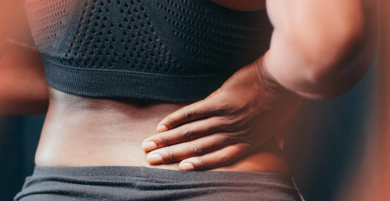Ever felt that nagging pain in your lower back right when your period starts or even before? You’re not alone. Back pain during periods is one of those pesky symptoms that can turn an already uncomfortable time into a full-blown struggle.
Let’s discuss everything you need to know about period back pain. From understanding the cause of lower back pain in women (hint: hormones have a starring role) to tips on managing it effectively during, before, and after your period. We’ve got you covered. Let’s turn your pain into power with some simple solutions and expert insights.
Causes Of Lower Back Pain During Periods
The causes of back pain in periods can vary from mild discomfort to severe pain that disturbs daily life. It usually begins a few days before menstruation – during PMS (premenstrual syndrome), and improves after your period ends. The pain is typically muscular due to hormonal changes.
Prostaglandin is a hormone that is released during the menstrual cycle to activate uterine contractions for shedding the uterine lining, and it can also affect the muscles in the lower back. When prostaglandin levels are too high, it can lead to dysmenorrhea aka painful periods, leading to upper back pain during periods. Intense contractions may cause pain to discharge from the lower abdomen to the lower back.
Back pain during periods is often linked to hormonal fluctuations. Whereas for women with conditions like endometriosis, this pain can be more evident during their menstrual cycle. The good news here is that, in most cases, lower back pain during the menstrual cycle is common and usually not a severe one. It resolves on its own once your period ends. Still, understanding the causes, learning tips to manage, and steps to take if it is severe makes all the difference.
Simple Remedies For Lower Back Pain
1. Apply Heat Therapy
Use a heating pad or hot water bottle on your lower back or abdomen, it can help relax the muscles and reduce cramps.
- Applying heat improves blood flow to the lower back area, easing pain and stiffness.
- Try applying heat for 15-20 minutes at a time, a few times a day, especially when the pain is heavy–a simple home remedy for period pain relief.
2. Practice Gentle Stretches And Regular Exercise
It might be tempting to stay in bed, but a light physical activity like walking or cycling can reduce pain moderately. These exercises help release endorphins, the body's natural pain relievers.
- Light stretching or doing yoga are the best relief methods to relieve back pain.
- Try the child’s pose or cat-cow stretch which can ease muscle tension and improve blood circulation.
- Practice other relaxation techniques like deep breathing, meditation, or progressive muscle relaxation constantly to reduce pain gradually.
- These exercises help release endorphins, the body's natural pain relievers.
- Aim to stretch for 10-15 minutes daily or whenever the pain becomes bothersome.
- The National Institute of Neurological Disorders and Stroke says acupuncture can be moderately effective in treating lower back pain.
Use a heating pad or hot water bottle on your lower back or abdomen, it can help relax the muscles and reduce cramps.
Take Over-The-Counter Pain Relievers
Some women feel relieved by taking non-prescription medications like ibuprofen or naproxen, which can help reduce inflammation and relieve pain.
- These act as Instant relief from period back pain when taken at the first sign of discomfort.
- However, it is important to use them as directed and avoid overuse to prevent side effects.
Stay Hydrated
Drinking plenty of water can not only relieve severe lower back pain too, but also reduce bloating, which often worsens cramps.
- Proper hydration also prevents muscle cramps caused by dehydration–which is inevitable during periods.
- Keep a water bottle handy and drink 8-10 glasses of water daily throughout your cycle.
Consider Taking Magnesium And Calcium Supplements
- Magnesium and calcium are known to relax muscles and reduce cramps. Taking these supplements to your routine may help alleviate menstrual pain over time.
- However, it’s important to consult a doctor before starting any supplement and aim to include foods rich in these minerals, such as leafy greens and nuts in your diet.
Get Enough Sleep
- The way you sleep at night can impact your back pain, potentially making it worse. Choosing a sleeping position that minimizes strain on your back is one of several strategies you can try to ease discomfort during your period.
- Try using supportive pillows and find a sleeping position that alleviates back pressure, such as lying on your side with a pillow between your knees––a period pain relief exercise in bed.
Remember it’s mostly the hormones that cause you back pain during your menstrual cycle. If in any case, you’re experiencing intense lower back pain that extremely impacts your daily life, it's a good idea to consult a healthcare professional. Here are a few other symptoms to keep a look out for-
- When your back pain lasts for more than 10 days.
- Back pain that comes with numbness or tingling in the legs or feet.
- Lower back pain accompanied by weakness in the legs or feet.
- The pain that comes with difficulty controlling your bladder.
- Lower back pain along with a fever.
It is also wise to reach out to your doctor if you think you might have any aforementioned underlying conditions. Also, if you notice a variety of uncomfortable symptoms during your period such as bleeding lasting for more than 10 days, more abdomen pains, or cramps, it is a sign of an underlying condition–and an immediate doctor consultation.
Table of content
- माहवारी के दौरान मीठा खाने की प्रबल इच्छा बढ़ती क्यों है?
- मिठाई खाने की लालसा को नियंत्रित करने के उपाय
- दिवाली की मिठाइयां: चुनौती
- दिवाली में हर दिन का चीनी का सेवन कैसे कम करें?
- माहवारी की ब्लोटिंग और त्योहारों की दावतें
- छुट्टियों में होने वाली ब्लोटिंग से कैसे बचा जाए
- PCOS, डायबिटीज़ और चीनी का सेवन
- त्यौहार मनाने का आनंद लें











